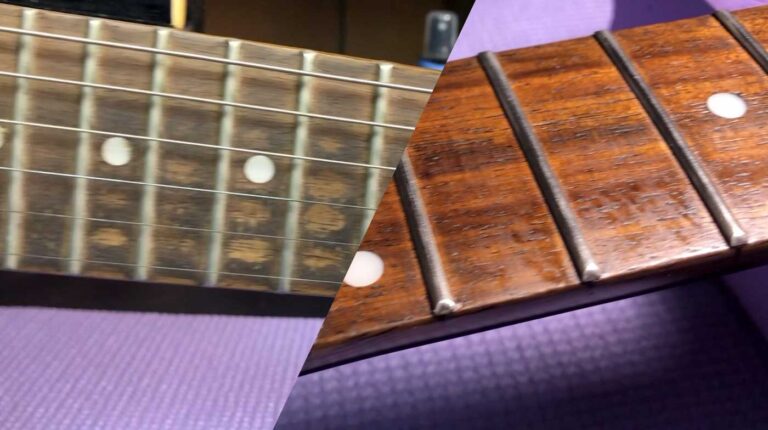Taking care of your beloved acoustic or electric guitar is not just about playing it; it’s about ensuring it stays in top-notch condition. In this comprehensive guide, we’ll delve into the intricacies of guitar care and maintenance, covering everything from storage to cleaning and string replacement. Let’s ensure your guitar looks good, sounds great, and stands the test of time.
How to Store a Guitar: Ensuring Safety Beyond the Strum
1. Keep it in a Case
If your guitar isn’t being played, its safest home is in a guitar case. While stands are convenient, a guitar case provides a protective shield against accidents. Ensure the room’s humidity is monitored, as fluctuations can affect your instrument. Storing in a case makes it easier to control the environment and is highly recommended.
2. Dramatic Temperature Changes
Guitars are sensitive to temperature shifts, especially during travel. Rapid changes can harm the instrument. If exposed to extreme temperatures, let the guitar adjust slowly in its case. Crack it open to speed up the process, ensuring a smooth transition.
3. Maintain Consistent Humidity
Proper humidification is crucial, particularly for acoustic guitars. Investing in a humidification system to maintain 45% – 50% humidity prevents issues like cracks, sharp fret ends, and failed bridges. Learn more about why maintaining humidity is essential for your guitar’s longevity.

Guitar Bag – Optimal Protection for Your 41 Inch Acoustic Guitar, Water Resistent, Adjustable Shoulder Straps, Black CY0152
The CAHAYA 41 Inch Acoustic Guitar Bag is the go-to choice for musicians seeking reliable protection for their instrument. Specifically designed to accommodate 39/40/41 inch guitars, this gig bag ensures your guitar is shielded from light rain and transportation bumps.
How to Clean a Guitar: Daily Practices for a Shiny Fretboard
1. Daily Cleaning Practices
Wash your hands before playing to protect your guitar from dirt and oils. Wiping it down after playing is a good habit, paying extra attention to strings and hardware. Regular cleaning keeps your guitar shiny, extends string life, and prevents hardware tarnishing.
2. Fretboard Maintenance
Clean the fretboard when changing or removing strings. Use fretboard conditioners to keep it hydrated and shiny, preventing issues like fret sprouting or cracks. Caution: Maple fretboards require a different approach. Check our article on cleaning maple fretboards for detailed instructions.
3. Polishing the Finish
Before reaching for guitar polish, remove dust and fingerprints with a microfiber cloth. Ensure there are no metal flakes or debris that could scratch the finish. Lightly spray the cloth with polish and wipe the guitar in circular patterns, including the back of the neck and headstock.

MusicNomad Ultimate at Home Guitar and Bass Work Station (MN290)
The MusicNomad Ultimate at Home Guitar and Bass Work Station is the go-to solution for guitar and bass enthusiasts. Made in the USA, this premium work station ensures the highest quality and durability.
How to Change Guitar Strings: Breathing New Life Into Your Melodies
1. Know When to Change
Frequent string changes inject new life into your guitar. Factors like play frequency and location influence string lifespan. Learn the signs indicating it’s time for new strings, such as tuning instability, loss of tone, or buildup on the strings.
2. Clean Strings Instead
Dirty strings don’t always require replacement. Learn effective methods for cleaning your strings, saving you money and preserving the playability of your guitar.
3. Why People Change Strings
Understand the reasons behind string changes, from replacing broken strings to achieving a specific sound or tuning. Explore our guides for selecting and installing the right strings for your guitar.

Ernie Ball Regular Slinky Nickel Wound Electric Guitar Strings 3 Pack – 10-46 Gauge
Ernie Ball Regular Slinky Nickel Wound Electric Guitar Strings 3 Pack – 10-46 Gauge is the top-selling set, known for its superior tone and balanced feel. Favored by legends like Eric Clapton and Slash, these strings offer endless play possibilities with a bright, balanced tone.
Do Your Own Setups – The Tools You Need
Explore the ultimate Guitar Care and Maintenance Guide for acoustic and electric guitars. Learn storage tips, daily cleaning practices, fretboard maintenance, string-changing techniques, and more. Keep your strings strumming and frets fretting with expert advice.
HASHTAGS:
GuitarCare, GuitarMaintenance, StringCare, FretboardMaintenance, GuitarTips, MusicianLife, InstrumentMaintenance, GuitarStrings, MusicGear, SweetwaterGuide




